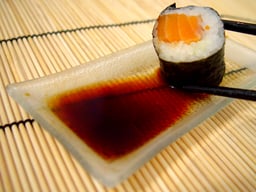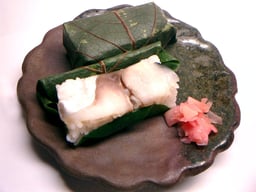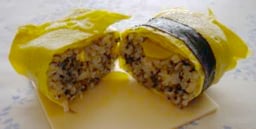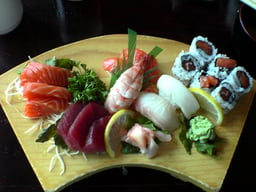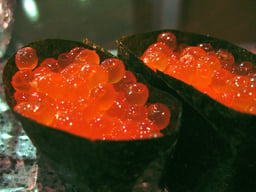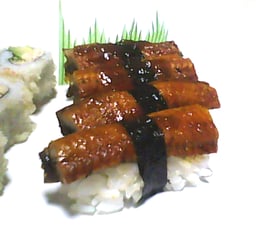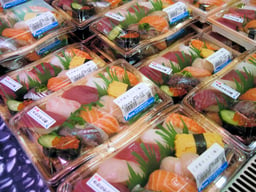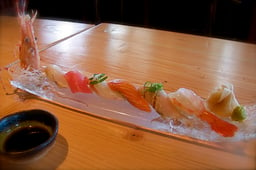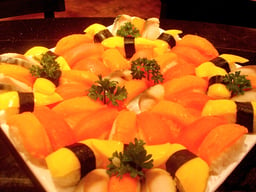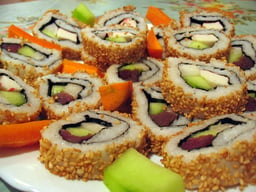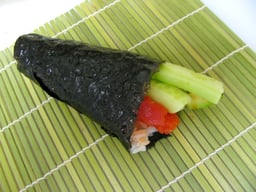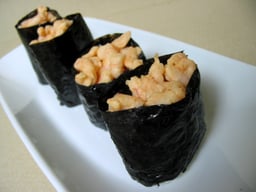Sushi
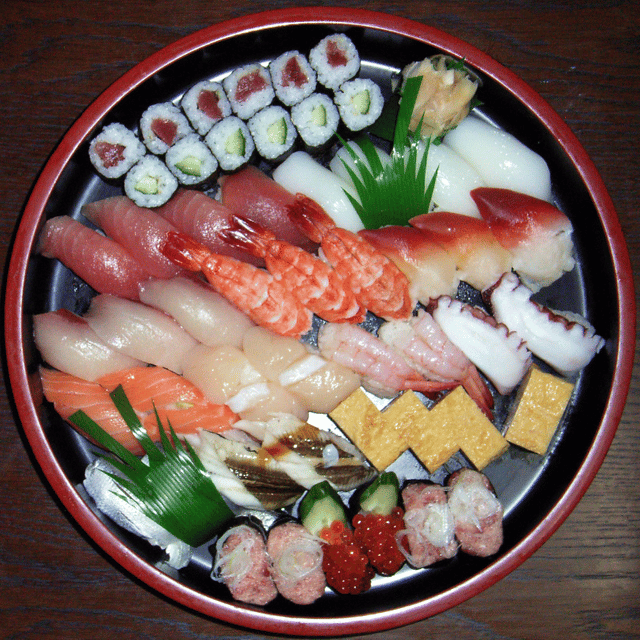
Sushi

| Alternative names | すし, 寿司, 鮨 |
|---|---|
| Course | appetizer, main dish |
| Place of origin | Japan |
| Associatednational cuisine | Japanese cuisine |
| Serving temperature | cold |
| Main ingredients | vinegared rice |
| Ingredients generally used | seafood and vegetables |
| Sushi | |
| Japanese name | |
| Kyūjitai | |
| Shinjitai | |
Sushi (すし, 寿司, 鮨, pronounced [sɯ̥ɕiꜜ] or [sɯ̥ꜜɕi]) is a Japanese dish of prepared vinegared rice (鮨飯, sushi-meshi), usually with some sugar and salt, accompanying a variety of ingredients (ネタ, neta), such as seafood, vegetables, and occasionally tropical fruits. Styles of sushi and its presentation vary widely, but the one key ingredient is "sushi rice", also referred to as shari (しゃり), or sumeshi (酢飯).
Sushi is traditionally made with medium-grain white rice, though it can be prepared with brown rice or short-grain rice. It is very often prepared with seafood, such as squid, eel, yellowtail, salmon, tuna or imitation crab meat. Many types of sushi are vegetarian. It is often served with pickled ginger (gari), wasabi, and soy sauce. Daikon radish or pickled daikon (takuan) are popular garnishes for the dish.
Sushi is sometimes confused with sashimi, a related dish in Japanese cuisine that consists of thinly sliced raw fish, or occasionally meat, and an optional serving of rice.[1]
| Alternative names | すし, 寿司, 鮨 |
|---|---|
| Course | appetizer, main dish |
| Place of origin | Japan |
| Associatednational cuisine | Japanese cuisine |
| Serving temperature | cold |
| Main ingredients | vinegared rice |
| Ingredients generally used | seafood and vegetables |
| Sushi | |
| Japanese name | |
| Kyūjitai | |
| Shinjitai | |
History

Sushi by Hiroshige in Edo period

Osaka-style sushi, also called "Oshi-zushi" or "hako-sushi"
Sushi originates in a Southeast Asian dish, known today as narezushi (馴れ寿司, 熟寿司 – "salted fish"), stored in fermented rice for possibly months at a time. The lacto-fermentation of the rice prevented the fish from spoiling;[2] the rice would be discarded before consumption of the fish.[3] This early type of sushi became an important source of protein for its Japanese consumers. The term sushi comes from an antiquated grammatical form no longer used in other contexts, and literally means "sour-tasting"; the overall dish has a sour and umami or savoury taste.[4] Narezushi still exists as a regional specialty, notably as funa-zushi from Shiga Prefecture.[5]
Vinegar began to be added to the preparation of narezushi in the Muromachi period (1336–1573) for the sake of enhancing both taste and preservation. In addition to increasing the sourness of the rice, the vinegar significantly increased the dish's longevity, causing the fermentation process to be shortened and eventually abandoned. The primitive sushi would be further developed in Osaka, where over several centuries it became oshi-zushi or "hako-zushi"; in this preparation, the seafood and rice were pressed into shape with wooden (typically bamboo) molds.
It was not until the Edo period (1603–1868) that fresh fish was served over vinegared rice and nori. The particular style of today's nigirizushi became popular in Edo (contemporary Tokyo) in the 1820s or 1830s. One common story of *nigirizushi'*s origins is of the chef Hanaya Yohei (1799–1858), who invented or perfected the technique in 1824 at his shop in Ryōgoku.[5]Tsukiji%3A%20The%20Fi]]he dish was originally termed as it used freshly caught fish from theTokyo Bay); the term e nigirizushi is still used today as a by-word for quality sushi, regardless of its ingredients' origins.[6][7]
The earliest written mention of sushi in English described in the Oxford English Dictionary is in an 1893 book, A Japanese Interior, where it mentions sushi as "a roll of cold rice with fish, sea-weed, or some other flavoring".[8][9] There is an earlier mention of sushi in James Hepburn's Japanese-English dictionary from 1873,[10] and an 1879 article on Japanese cookery in the journal Notes and Queries.[11]
Types

Sushi platter in takeway
The common ingredient in all types of sushi is vinegared sushi rice. Fillings, toppings, condiments, and preparation vary widely.[12]
Due to rendaku consonant mutation, sushi is spelled with zu instead of su when a prefix is attached, as in nigirizushi.
Chirashizushi

Chirashizushi with raw ingredients
Chirashizushi (ちらし寿司, "scattered sushi", also referred to as barazushi) serves the rice in a bowl and tops it with a variety of raw fish and vegetable garnishes. It is commonly eaten because it is filling, fast and easy to make. It is eaten annually on Hinamatsuri in March.
Edomae chirashizushi (Edo-style scattered sushi) is served with uncooked ingredients in an artful arrangement.
Gomokuzushi (Kansai-style sushi) consists of cooked or uncooked ingredients mixed in the body of rice.
Sake-zushi (Kyushu-style sushi) uses rice wine over vinegar in preparing the rice, and is topped with shrimp, sea bream, octopus, shiitake mushrooms, bamboo shoots and shredded omelette.
Inarizushi
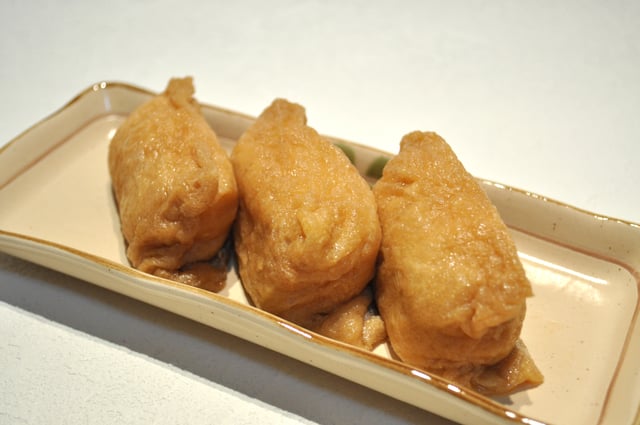
Three pieces of inarizushi
Inarizushi (稲荷寿司) is a pouch of fried tofu typically filled with sushi rice alone.
Regional variations include pouches made of a thin omelette (帛紗寿司, fukusa-zushi, or 茶巾寿司, chakin-zushi) instead of tofu. It should not be confused with inari maki, which is a roll filled with flavored fried tofu. In Korean, inarizushi called yubuchobap (유부초밥).
Cone sushi is a variant of inarizushi originating in Hawaii that may include green beans, carrots, or gobo along with rice, wrapped in a triangular abura-age piece. It is often sold in okazu-ya (Japanese delis) and as a component of bento boxes.[14][15][16]*Go%20Home%2C%20Cook%20Rice%3A%20A%20Guide%20to%20Buy]]*Go%20Home%2C%20Cook%20Rice%3A%20A%20Guide%20to%20Buy]]*Go%20Home%2C%20Cook%20Rice%3A%20A%20Guide%20to%20Buy]]*Go%20Home%2C%20Cook%20Rice%3A%20A%20Guide%20to%20Buy]]*Go%20Home%2C%20Cook%20Rice%3A%20A%20Guide%20to%20Buy]]*Go%20Home%2C%20Cook%20Rice%3A%20A%20Guide%20to%20Buy]]*Go%20Home%2C%20Cook%20Rice%3A%20A%20Guide%20to%20Buy]]*Go%20Home%2C%20Cook%20Rice%3A%20A%20Guide%20to%20Buy]]Go%20Home%2C%20Cook%20Rice%3A%20A%20Guide%20to%20Buy]]
Makizushi

Futomaki

Fried futomaki with soy sauce
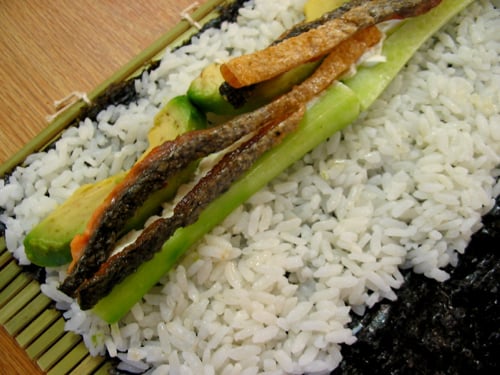
Makizushi in preparation

Square-style makizushi made without nori. The bottom pieces have been seasoned with wasabi

Ehōmaki
Makizushi (巻き寿司, "rolled sushi"), norimaki (海苔巻き, "Nori roll") or makimono (巻物, "variety of rolls") is a cylindrical piece, formed with the help of a bamboo mat known as a makisu (巻き簾). Makizushi is generally wrapped in nori (seaweed), but is occasionally wrapped in a thin omelette, soy paper, cucumber, or shiso (perilla) leaves. Makizushi is usually cut into six or eight pieces, which constitutes a single roll order. Below are some common types of makizushi, but many other kinds exist.
Futomaki (太巻, "thick, large or fat rolls") is a large cylindrical piece, usually with nori on the outside.[18] A typical futomaki is five to six centimetres (2 to 2 1⁄2 in) in diameter.[19] They are often made with two, three, or more fillings that are chosen for their complementary tastes and colors. During the evening of the Setsubun festival, it is traditional in the Kansai region to eat uncut futomaki in its cylindrical form, where it is called ehō-maki (恵方巻, lit. happy direction rolls).[20] By 2000 the custom had spread to all of Japan.[20] Futomaki are often vegetarian, and may utilize strips of cucumber, kampyō gourd, takenoko bamboo shoots, or lotus root. Strips of tamagoyaki omelette, tiny fish roe, chopped tuna, and oboro (food) whitefish flakes are typical non-vegetarian fillings.[18] Traditionally, the rice is lightly seasoned with salt and sesame oil/perilla oil. Popular protein ingredients are fish cakes, imitation crab meat, eggs, or seasoned beef rib-eye. Vegetables usually include cucumbers, spinach, carrot and takuan (沢庵) (pickled radish). After the makizushi has been rolled and sliced, it is typically served with takuan.
Short grain white rice is usually used, although short-grain brown rice, like olive oil on nori, is now becoming more widespread among the health-conscious. Rarely, sweet rice is mixed in makizushi rice. Nowadays, the rice in makizushi can be many kinds of black rice, boiled rice and cereals etc.Besides the common ingredients listed above, some varieties may include cheese, spicy cooked squid, yakiniku, kamaboko, lunch meat, sausage, bacon or spicy tuna. The nori may be brushed with sesame oil or sprinkled with sesame seeds. In a variation, sliced pieces of makizushi may be lightly fried with egg coating. Tamago makizushi (玉子巻き寿司) is makizushi is rolled out by a thin egg. Tempura Makizushi (天ぷら 巻き寿司) or Agezushi (揚げ寿司ロール) is a fried version of the dish.
Hosomaki (細巻, "thin rolls") is a small cylindrical piece, with nori on the outside. A typical hosomaki has a diameter of about 2.5 centimetres (1 in).[19] They generally contain only one filling, often tuna, cucumber, kanpyō, thinly sliced carrots, or, more recently, avocado. Kappamaki, (河童巻) a kind of Hosomaki filled with cucumber, is named after the Japanese legendary water imp fond of cucumbers called the kappa. Traditionally, kappamaki is consumed to clear the palate between eating raw fish and other kinds of food, so that the flavors of the fish are distinct from the tastes of other foods. Tekkamaki (鉄火巻) is a kind of hosomaki filled with raw tuna. Although it is believed that the word tekka, meaning "red hot iron", alludes to the color of the tuna flesh or salmon flesh, it actually originated as a quick snack to eat in gambling dens called tekkaba (鉄火場), much like the sandwich.[22][23] Negitoromaki (ねぎとろ巻) is a kind of hosomaki filled with scallion (negi) and chopped tuna (toro). Fatty tuna is often used in this style. Tsunamayomaki (ツナマヨ巻) is a kind of hosomaki filled with canned tuna tossed with mayonnaise.
Ehōmaki (恵方巻, "lucky direction roll") is a roll composed of seven ingredients considered to be lucky. Ehōmaki are often eaten on setsubun in Japan. The typical ingredients include kanpyō, egg, eel, and shiitake mushrooms. Ehōmaki often include other ingredients too. People usually eat the ehōmaki while facing the direction considered to be auspicious that year.[24]
Temaki (手巻, "hand roll") is a large cone-shaped piece of nori on the outside and the ingredients spilling out the wide end. A typical temaki is about 10 centimetres (4 in) long, and is eaten with fingers because it is too awkward to pick it up with chopsticks. For optimal taste and texture, temaki must be eaten quickly after being made because the nori cone soon absorbs moisture from the filling and loses its crispness, making it somewhat difficult to bite through. For this reason, the nori in pre-made or take-out temaki is sealed in plastic film which is removed immediately before eating.[25]
Modern Narezushi

funa-zushi (narezushi made from a crucian carp species)
Narezushi (熟れ寿司, "matured sushi") is a traditional form of fermented sushi. Skinned and gutted fish are stuffed with salt, placed in a wooden barrel, doused with salt again, then weighed down with a heavy tsukemonoishi (pickling stone). As days pass, water seeps out and is removed. After six months, this sushi can be eaten, remaining edible for another six months or more.[26]
The most famous variety of narezushi are the ones offered as a specialty dish of Shiga Prefecture,[27] particularly the funa-zushi made from fish of the crucian carp genus, the authentic version of which calls for the use nigorobuna, a particular locally differentiated variety of wild goldfish endemic to Lake Biwa).[28]
Nigirizushi
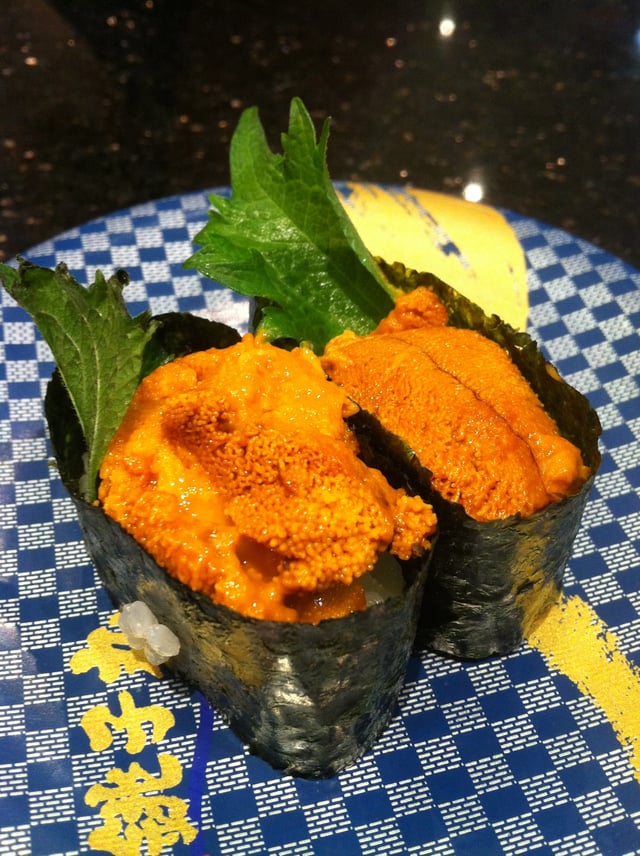
Sea urchin roe "gunkanmaki"
Nigirizushi (握り寿司, "hand-pressed sushi") consists of an oblong mound of sushi rice that the chef presses between the palms of the hands to form an oval-shaped ball, and a topping (the neta) draped over the ball. It is usually served with a bit of wasabi; neta are typically fish such as salmon, tuna or other seafood. Certain toppings are typically bound to the rice with a thin strip of nori, most commonly octopus (tako), freshwater eel (unagi), sea eel (anago), squid (ika), and sweet egg (tamago). One order of a given type of fish typically results in two pieces, while a sushi set (sampler dish) may contain only one piece of each topping.
Gunkanmaki (軍艦巻, "warship roll") is a special type of nigirizushi: an oval, hand-formed clump of sushi rice that has a strip of nori wrapped around its perimeter to form a vessel that is filled with some soft, loose or fine-chopped ingredient that requires the confinement of nori such as roe, nattō, oysters, uni (sea urchin roe), corn with mayonnaise, scallops, and quail eggs. Gunkan-maki was invented at the Ginza Kyubey restaurant in 1941; its invention significantly expanded the repertoire of soft toppings used in sushi.[29][30]
Temarizushi (手まり寿司, "ball sushi") is a sushi made by pressing rice and fish into a ball-shaped form by hand using a plastic wrap.
Oshizushi
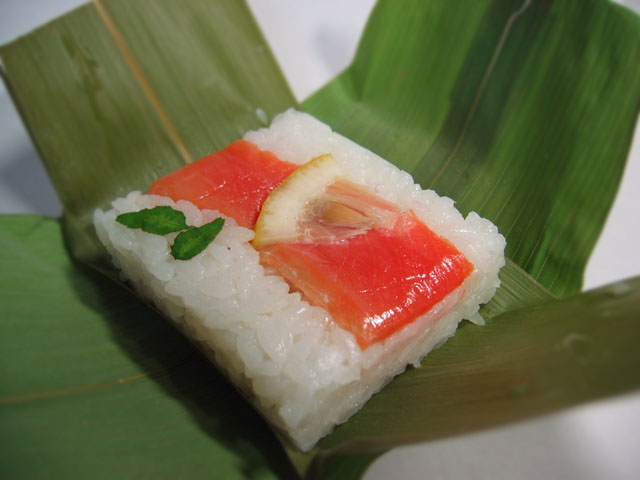
Sasazushi, a type of oshizushi
Oshizushi (押し寿司, "pressed sushi"), also known as hako-zushi (箱寿司, "box sushi"), is a pressed sushi from the Kansai region, a favorite and specialty of Osaka. A block-shaped piece is formed using a wooden mold, called an oshibako. The chef lines the bottom of the oshibako with the toppings, covers them with sushi rice, and then presses the lid of the mold down to create a compact, rectilinear block. The block is removed from the mold and then cut into bite-sized pieces. Particularly famous is バッテラ (battera, pressed mackerel sushi) or 鯖寿司 (saba zushi).[31] In oshizushi, all the ingredients are either cooked or cured and raw fish is never used.[32]
Western-style sushi

Norway roll (ノルウェー巻き).
The increasing popularity of sushi around the world has resulted in variations typically found in the Western world, but rarely in Japan. A notable exception to this is the use of salmon, which was introduced by a Norwegian businessman tasked with helping the Norwegian salmon industry in the 1980s.[34][35][33] Such creations to suit the Western palate were initially fueled by the invention of the California roll (a norimaki with crab (later, imitation crab), cucumber, and avocado). A wide variety of popular rolls (norimaki and uramaki) has evolved since. Norway roll is another variant of uramakizushi filled with tamago (omelette), imitation crab and cucumber, rolled with shiso leaf and nori, topped with slices of Norwegian salmon, garnished with lemon and mayonnaise.[36]
Uramaki
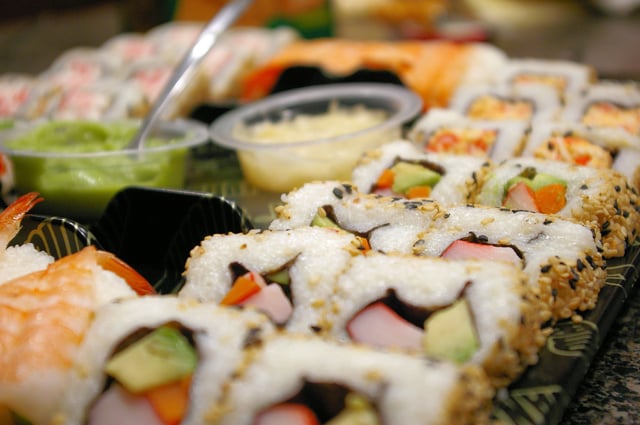
Uramakizushi rolls
Uramaki (裏巻, "inside-out roll") is a medium-sized cylindrical piece with two or more fillings, and was developed as a result of the creation of the California roll, as a method originally meant to hide the nori. Uramaki differs from other makimono because the rice is on the outside and the nori inside. The filling is in the center surrounded by nori, then a layer of rice, and optionally an outer coating of some other ingredients such as roe or toasted sesame seeds. It can be made with different fillings, such as tuna, crab meat, avocado, mayonnaise, cucumber or carrots.
Examples of variations include the rainbow roll (an inside-out topped with thinly sliced maguro, hamachi, ebi, sake and avocado) and the caterpillar roll (an inside-out topped with thinly sliced avocado). Also commonly found is the "rock and roll" (an inside-out roll with barbecued freshwater eel and avocado with toasted sesame seeds on the outside).
In Japan, uramaki is an uncommon type of makimono; because sushi is traditionally eaten by hand in Japan, the outer layer of rice can be quite difficult to handle with fingers.[37]
American-style makizushi

American shrimp tempura and spicy salmon rolls
Futomaki is a more popular variation of sushi within the United States, and comes in variations that take their names from their places of origin. Other rolls may include a variety of ingredients, including chopped scallops, spicy tuna, beef or chicken teriyaki roll, okra, and assorted vegetables such as cucumber and avocado, and the tempura roll, where shrimp tempura is inside the roll or the entire roll is battered and fried tempura-style. In the Southern United States, many sushi restaurants prepare rolls using crawfish. Sometimes, rolls are made with brown rice or black rice, which appear in Japanese cuisine as well.
Per Food and Drug Administration regulations, raw fish served in the United States must be frozen prior to serving in order to kill parasites.[38] Because of this and the relative difficulty of acquiring fresh seafood compared to Japan, raw seafood (e.g., sashimi) is not as prevalent a component in American-style sushi.
Since rolls are often made to-order it is not unusual for the customer to specify the exact ingredients desired (e.g. salmon roll, cucumber roll, avocado roll, tuna roll, shrimp or tuna tempura roll, etc.). Though the menu names of dishes often vary by restaurant, some examples include:
| Sushi roll name | Definition |
|---|---|
| Alaskan roll | a variant of theCalifornia rollwith raw salmon on the inside, or layered on the outside.[39] |
| Boston roll | AnuramakiCalifornia rollwithpoachedshrimpinstead ofimitation crab.[40] |
| British Columbia roll | contains grilled or barbecued salmon skin, cucumber, sweet sauce, sometimes withroe.Also sometimes referred to as salmon skin rolls outside of British Columbia, Canada.[41] |
| California roll | consists ofavocado, kani kama (imitation crab/crab stick) (also can contain real crab in "premium" varieties),cucumber, andtobiko, often made as uramaki (with rice on the outside,norion the inside)[42] |
| Dynamite roll | includesyellowtail( hamachi) or prawntempura, and fillings such as bean sprouts, carrots, avocado, cucumber, chili, spicy mayonnaise, and roe.[43] |
| Hawaiian roll | containsshoyutuna (canned),tamago,kanpyō,kamaboko, and the distinctive red and green hana ebi (shrimp powder).[44] |
| Mango roll | includes fillings such as avocado, crab meat, tempura shrimp, mango slices, and topped off with a creamy mango paste.[45] |
| Michigan roll | includes fillings such as spicy tuna, smelt roe, spicy sauce, avocado, and sushi rice.Is a variation on spicy tuna roll.[46] |
| New Mexico roll | originating inNew Mexico; includesNew Mexico green chile(sometimes tempura fried), teriyaki sauce, and rice.[47][48]Sometimes simply referred to as a "green chile (tempura) roll" within the state.[49][50] |
| Philadelphia roll | consists of raw or smoked salmon,cream cheese(the name refers toPhiladelphia cream cheese), cucumber or avocado, or onion.[51] |
| Rainbow roll | is a California rolluramakiwith multiple types of fish (commonly yellowtail, tuna, salmon, snapper, white fish, eel, etc.) and avocado wrapped around it.[52] |
| Seattle roll | consists of cucumber, avocado, cream cheese and raw orsmoked salmon.[53] |
| Spicy tuna roll | includes raw tuna mixed with hot sauce infused mayonnaise. |
| Spider roll | includes friedsoft-shell craband other fillings such as cucumber, avocado, daikon sprouts or lettuce, roe, and sometimes spicy mayonnaise.[54] |
| Sushi burrito | a large, customizable roll offered in a number of "sushi burrito" restaurants in the United States.[55] |
Ingredients

Video of making sushi without fish

Sushi chef preparing nigirizushi, Kyoto, Japan
All sushi has a base of specially prepared rice, complemented with other ingredients.
Sushi-meshi
Sushi-meshi 鮨飯 (also known as Su-meshi 酢飯, shari 舎利, or gohan ご飯) is a preparation of white, short-grained, Japanese rice mixed with a dressing consisting of rice vinegar, sugar, salt, and occasionally kombu and sake. It has to be cooled to room temperature before being used for a filling in a sushi or else it will get too sticky while being seasoned. Traditionally, the mixing is done with a hangiri, which is a round, flat-bottom wooden tub or barrel, and a wooden paddle (shamoji).
Sushi rice is prepared with short-grain Japanese rice, which has a consistency that differs from long-grain strains such as those from India, Sri Lanka, Bangladesh, Thailand, and Vietnam. The essential quality is its stickiness or glutinousness, although the type of rice used for sushi is different from glutinous rice. Freshly harvested rice (shinmai) typically contains too much water, and requires extra time to drain the rice cooker after washing. In some fusion cuisine restaurants, short-grain brown rice and wild rice are also used.
There are regional variations in sushi rice and individual chefs have their individual methods.
Most of the variations are in the rice vinegar dressing: the Kantō region (or East Japan) version of the dressing commonly uses more salt; in Kansai region (or West Japan), the dressing has more sugar.
Nori

Sheets of nori.
The black seaweed wrappers used in makimono are called nori (海苔). Nori is a type of algae, traditionally cultivated in the harbors of Japan. Originally, algae was scraped from dock pilings, rolled out into thin, edible sheets, and dried in the sun, in a process similar to making rice paper.[56] Today, the commercial product is farmed, processed, toasted, packaged, and sold in sheets.
The size of a nori sheet influences the size of makimono. A full-size sheet produces futomaki, and a half produces hosomaki and temaki. To produce gunkan and some other makimono, an appropriately-sized piece of nori is cut from a whole sheet.
Nori by itself is an edible snack and is available with salt or flavored with teriyaki sauce. The flavored variety, however, tends to be of lesser quality and is not suitable for sushi.
When making fukusazushi, a paper-thin omelette may replace a sheet of nori as the wrapping. The omelette is traditionally made on a rectangular omelette pan, known as a makiyakinabe, and used to form the pouch for the rice and fillings.[57]
Gu

Sushi made of meats other than fish (whether raw or cooked) is a variation often seen in Japan.
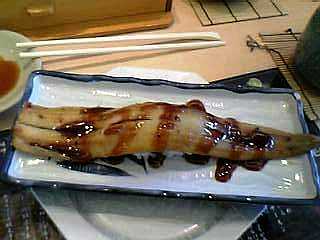
Yaki anago-ippon-nigiri (焼きアナゴ一本握り) – a roasted and sweet-sauced whole conger

Ebifurai-maki (エビフライ巻き) – fried-shrimp roll
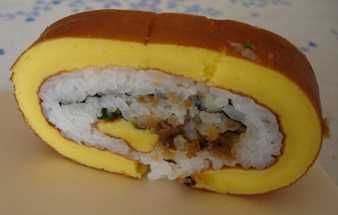
Date-Maki (伊達巻) – futomaki wrapped with sweet tamagoyaki
The ingredients used inside sushi are called gu, and are, typically, varieties of fish.[58] For culinary, sanitary, and aesthetic reasons, the minimum quality and freshness of fish to be eaten raw must be superior to that of fish which is to be cooked. Sushi chefs are trained to recognize important attributes, including smell, color, firmness, and freedom from parasites that may go undetected in commercial inspection. Commonly used fish are tuna (maguro, shiro-maguro), Japanese amberjack, yellowtail (hamachi), snapper (kurodai), mackerel (saba), and salmon (sake). The most valued sushi ingredient is toro, the fatty cut of the fish.[59] This comes in a variety of ōtoro (often from the bluefin species of tuna) and chūtoro, meaning "middle toro", implying that it is halfway into the fattiness between toro and the regular cut. Aburi style refers to nigiri sushi where the fish is partially grilled (topside) and partially raw. Most nigiri sushi will have completely raw toppings, called neta.[58]
Other seafoods such as squid (ika), eel (anago and unagi), pike conger (hamo), octopus (tako), shrimp (ebi and amaebi), clam (mirugai, aoyagi and akagai), fish roe (ikura, masago, kazunoko and tobiko), sea urchin (uni), crab (kani), and various kinds of shellfish (abalone, prawn, scallop) are the most popular seafoods in sushi. Oysters, however, are less common, as the taste is not thought to go well with the rice. Kani kama, or imitation crab stick, is commonly substituted for real crab, most notably in California rolls.[60]
Pickled daikon radish (takuan) in shinko maki, pickled vegetables (tsukemono), fermented soybeans (nattō) in nattō maki, avocado, cucumber in kappa maki, asparagus,[61] yam, pickled ume (umeboshi), gourd (kanpyō), burdock (gobo), and sweet corn (possibly mixed with mayonnaise) are also used in sushi.
Tofu and eggs (in the form of slightly sweet, layered omelette called tamagoyaki and raw quail eggs ride as a gunkan-maki topping) are common.
Condiments
Sushi is commonly eaten with condiments.
Sushi may be dipped in shōyu (soy sauce), and is usually flavored with wasabi, a piquant paste made from the grated stem of the Wasabia japonica plant. Japanese-style mayonnaise is a common condiment in Japan on salmon, pork and other sushi cuts.
True wasabi has anti-microbial properties and may reduce the risk of food poisoning.[62] The traditional grating tool for wasabi is a sharkskin grater or samegawa oroshi. An imitation wasabi (seiyo-wasabi), made from horseradish, mustard powder and green dye is common. It is found at lower-end kaiten-zushi restaurants, in bento box sushi and at most restaurants outside Japan. If manufactured in Japan, it may be labelled "Japanese Horseradish".[63]
Gari (sweet, pickled ginger) is eaten in between sushi courses to both cleanse the palate and aid in digestion. In Japan, green tea (ocha) is invariably served together with sushi. Better sushi restaurants often use a distinctive premium tea known as mecha. In sushi vocabulary, green tea is known as agari.
Sushi may be garnished with gobo, grated daikon, thinly sliced vegetables, carrots/radishes/cucumbers that have been shaped to look like flowers, real flowers, or seaweed salad.
When closely arranged on a tray, different pieces are often separated by green strips called baran or kiri-zasa (切り笹). These dividers prevent the flavors of neighboring pieces of sushi from mixing and help to achieve an attractive presentation. Originally, these were cut leaves from the Aspidistra elatior (葉蘭 haran) and Sasa veitchii (熊笹 kuma-zasa) plants, respectively. Using actual leaves had the added benefit of releasing antimicrobial phytoncides when cut thereby extending the limited shelf life of the sushi.[64] Sushi bento boxes are a staple of Japanese supermarkets and convenience stores. As these stores began rising in prominence in the 1960s, the labor-intensive cut leaves were increasingly replaced with green plastic in order to lower costs. This coincided with the increased prevalence of refrigeration which acted to extend the shelf life of sushi without the need for the cut leaves. Today the plastic strips are commonly used in sushi bento boxes and to a lesser degree in sushi presentations found in sushi bars and restaurants. In store-sold or to-go packages of sushi, the plastic leaf strips are often used to prevent the rolls from coming into early or unwanted contact with the ginger and wasabi included with the dish.[65]
Nutrition

Sushi in shops are usually sold in plastic trays.
The main ingredients of traditional Japanese sushi, raw fish and rice, are naturally low in fat, high in protein, carbohydrates (the rice only), vitamins, and minerals, as are gari and nori. Other vegetables wrapped within the sushi also offer various vitamins and minerals. Many of the seafood ingredients also contain omega-3 fatty acids, which have a variety of health benefits.[66] The omega-3 fatty acids found in fish has certain beneficial properties, especially on cardiovascular health, natural anti-inflammatory compounds, and play a role in brain function.[67]
Generally sushi is not a particularly fattening food.
However, rice in sushi contains a fair amount of carbohydrates, plus the addition of other ingredients such as mayonnaise added into sushi rolls might increase the caloric content.[68] Sushi also has a relatively high sodium content, especially contributed from shoyu soy sauce seasoning.[67]
Health risks
Some of the ingredients in sushi can present health risks.
Large marine apex predators such as tuna (especially bluefin) can harbor high levels of methylmercury, which can lead to mercury poisoning when consumed in large quantity[69] or when consumed by certain higher-risk groups, including women who are pregnant or may become pregnant, nursing mothers and young children.[70]
According to recent studies, there have been about 18 million infections worldwide from eating raw fish.[71] This serves as a great risk to expecting mothers due to the health risks that medical interventions or treatment measures may pose on the developing fetus.[71] Parasitic infections can have a wide range of health impacts, including bowel obstruction, anemia, liver disease, and more.[71] The impact of these illnesses alone can pose some health concerns on the expecting mother and baby, but the curative measures that may need to take place to recover, are also a concern as well.[71]
Sashimi or other types of sushi containing raw fish present a risk of infection by three main types of parasites:
For the above reasons, EU regulations forbid the use of fresh raw fish.
It must be frozen at temperatures below −20 °C (−4 °F) in all parts of the product for no less than 24 hours.[75] As such, a number of fishing boats, suppliers and end users "super-freeze" fish for sushi to temperatures as low as −60 °C.[76] As well as parasite destruction, super-freezing also prevents oxidation of the blood in tuna flesh, thus preventing the discoloration that happens at temperatures above −20 °C.[77]
Some forms of sushi, notably those containing pufferfish fugu and some kinds of shellfish, can cause severe poisoning if not prepared properly. Particularly, fugu consumption can be fatal. Fugu fish has a lethal dose of tetrodotoxin in its internal organs and, by law in many countries, must be prepared by a licensed fugu chef who has passed the prefectural examination in Japan.[78] The licensing examination process consists of a written test, a fish-identification test, and a practical test that involves preparing the fugu and separating out the poisonous organs. Only about 35 percent of the applicants pass.[79]
Sustainable sushi
Sustainable sushi is sushi made from fished or farmed sources that can be maintained or whose future production does not significantly jeopardize the ecosystems from which it is acquired.
Concerns over the sustainability of sushi ingredients arise from greater concerns over environmental, economic and social stability and human health.
Presentation

Sushi served on a wooden platter at a sushi restaurant in Kanagawa Prefecture, Japan.
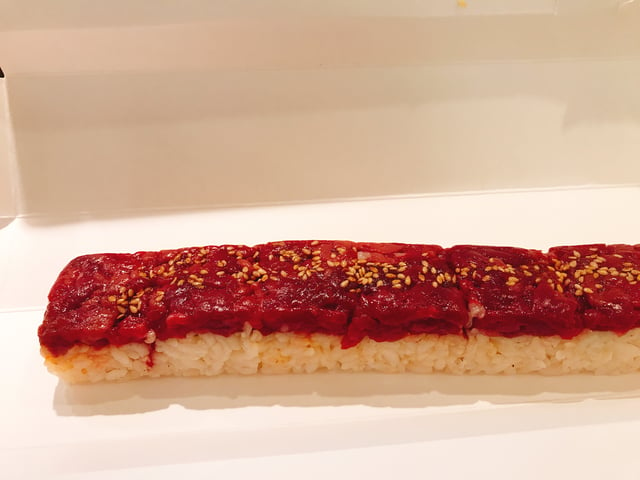
Meat sushi
Traditionally, sushi is served on minimalist Japanese-style, geometric, mono- or duo-tone wood or lacquer plates, in keeping with the aesthetic qualities of this cuisine.
Many sushi restaurants offer fixed-price sets, selected by the chef from the catch of the day.
These are often graded as shō-chiku-bai (松竹梅), shō/matsu (松, pine), chiku/take (竹, bamboo) and ume (梅, plum), with matsu the most expensive and ume the cheapest. Sushi restaurants will often have private booth dining, where guests are asked to remove their shoes, leaving them outside the room; However, most sushi bars offer diners a casual experience with an open dining room concept.
Sushi may be served kaiten zushi (sushi train) style. Color-coded plates of sushi are placed on a conveyor belt; as the belt passes, customers choose as they please. After finishing, the bill is tallied by counting how many plates of each color have been taken. Newer kaiten zushi restaurants use barcodes or RFID tags embedded in the dishes to manage elapsed time after the item was prepared.[80]
Glossary
Some specialized or slang terms are used in the sushi culture.
Most of these terms are used only in sushi bars.
Agari: "Rise up" Green tea. Ocha (お茶) in usual Japanese.
Gari: Sweet, pickled and sliced ginger, or sushi ginger. Shōga (生姜) in standard Japanese.
Gyoku: "Jewel". Sweet and cubic-shaped omelette. Tamagoyaki
Murasaki: "Violet" or "purple" (color). Soy sauce. Shōyu
Neta: Toppings on nigiri or fillings in makimono. Ne-ta is from reversal of ta-ne. Tane (種) in standard Japanese.
Oaiso: "Compliment". Bill or check. Oaiso may be used in not only sushi bars but also izakaya.[81][82] Okanjō or chekku (お勘定 or チェック) in standard Japanese.
Otemoto: Chopsticks. Otemoto means the nearest thing from the customer seated. Hashi
Sabi: Japanese horseradish. Contracted form of wasabi
Shari: Vinegar rice or rice. It may originally be from Sanskrit (zaali शालि) meaning rice or Śarīra. Gohan (ご飯) or meshi (飯) in standard Japanese.
Tsume: Sweet thick sauce mainly made of soy sauce. Nitsume (煮詰め) in standard Japanese.
Etiquette
Unlike sashimi, which is almost always eaten with chopsticks, nigirizushi is traditionally eaten with the fingers, even in formal settings.[83] Although it is commonly served on a small platter with a side dish for dipping, sushi can also be served in a bento
Soy sauce is the usual condiment, and sushi is normally served with a small sauce dish, or a compartment in the bento.
Traditional etiquette suggests that the sushi is turned over so that only the topping is dipped; this is because the soy sauce is for flavoring the topping, not the rice, and because the rice would absorb too much soy sauce and would fall apart.[84] If it is difficult to turn the sushi upside-down, one can baste the sushi in soy sauce using gari
Traditionally, the sushi chef will add an appropriate amount of wasabi to the sushi while preparing it, and etiquette suggests eating the sushi as is, since the chef is supposed to know the proper amount of wasabi to use. However, today wasabi is more a matter of personal taste, and even restaurants in Japan may serve wasabi on the side for customers to use at their discretion, even when there is wasabi already in the dish.[85]
| Utensil | Definition |
|---|---|
| Fukin | Kitchen cloth |
| Hangiri | Rice barrel |
| Hocho | Kitchen knives |
| Makisu | Bamboo rolling mat |
| RyoribashiorSaibashi | Cooking chopsticks |
| Shamoji | Wooden rice paddle |
| Makiyakinabe | Rectangular omelette pan |
| Oshizushihako | a mold used to makeoshizushi |

